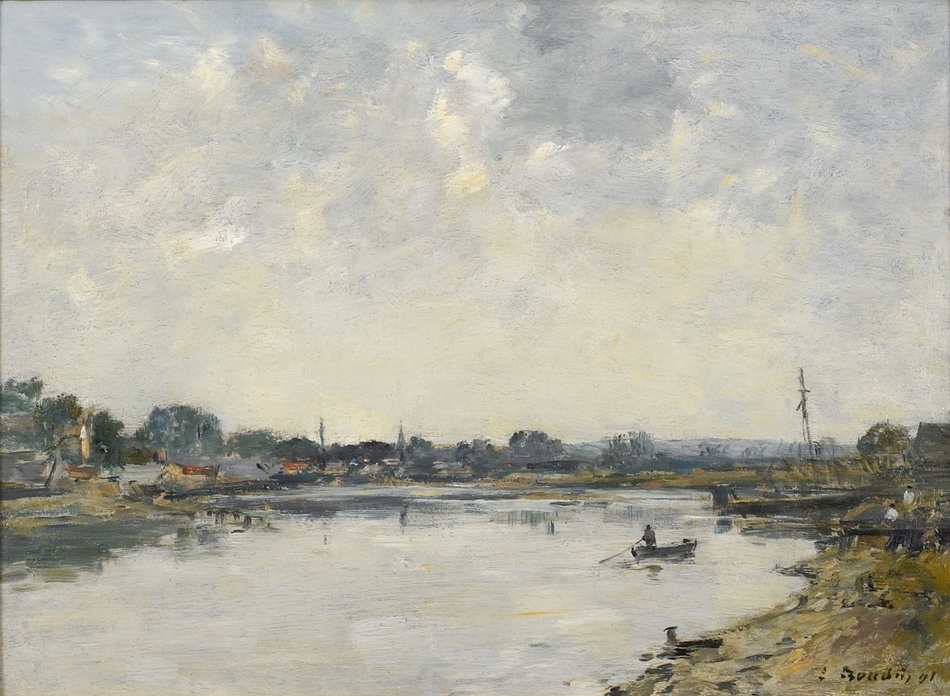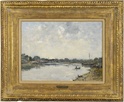La Somme à Saint-Valéry-sur-Somme
signed and dated lower right: E. Boudin 91
Provenance:
Durand Ruel, Paris
Watson Art Galleries, Montreal (no. 2826, label embossed 1897)
Schoneman Galleries, NY, 1954
Hirschl & Adler Galleries, NY
World House Galleries, NY
Private Collection, Cleveland OH
Literature:
Robert Schmidt, Eugène Boudin, catalogue raisonné de l’oeuvre peint, vol. III (Galerie Schmidt, Paris, 1973): no. 2801.
Eugène Boudin was born in Normandy in 1824 and died there in 1898. His father was a sailor on one of the first steamships that ran between Le Havre and Honfleur, and Boudin worked as cabin boy on his father's ship, observing from an early age the ever-changing sea and sky that would become his primary focus as a painter. In 1836, at age twelve, he began to work in a stationery and frame shop. The owner gave him a box of paints, but little else is known about Boudin's early interest in art. At twenty he co-owned a business, framing and selling the works of visiting artists. In 1847 he sold his half of the shop to pay his way out of military service. Sponsored by his former artist-clients, Boudin went to Paris to study and copy in the Louvre. In 1851 the town of Le Havre awarded him a three-year scholarship.
Boudin quickly established the pattern he would follow throughout his career: in summer he traveled to paint outdoor sketches that he would complete in his Paris studio over the winter. He stayed along the Channel coast, mostly in Normandy and Brittany. Though he painted inland landscapes, peasant scenes, and still lifes, it was the seaside, especially its river estuaries and harbors, that most attracted Boudin's eye. In 1862 he started painting the droves of fashionable tourists who vacationed at Normandy beach resorts. These pictures?his best known?were highly marketable and number in the thousands.
In the 1860s Boudin did not yet consider his outdoor studies fully finished; he felt they should be "poussé" (elaborated), as he said, to completion using notes, sketches, and memory. He meticulously recorded details about atmosphere, weather, and times of day (and inscribed this information on his sketches). He wrote to a student: "An impression is gained in an instant, but it then has to be condensed following the rules of art or rather your own feeling and that is the most difficult thing?to finish a painting without spoiling anything." At the same time, Boudin also claimed "everything that is painted directly and on the spot has always a strength, a power, a vivacity of touch which one cannot recover in the studio." Eventually Boudin would paint almost entirely en plein air, saying that one brushstroke placed outdoors was of more value than two days spent in the studio. His work foreshadowed impressionist concerns with atmosphere and the changing effects of weather and light. Corot called him "the king of the skies." The direct freshness of his works was a particular influence for Monet, who as a teenager worked alongside Boudin. As the modest Boudin himself wrote: "I may well have had some small measure of influence on the movement that led painters to study actual daylight and express the changing aspects of the sky with the utmost sincerity."
Request more information
News on the artist
-
Here is a wonderful Film of Pierre-Auguste Renoir Painting http://t.co/AvOdPHk via @youtube #ImpressionismAugust 8, 2011 @ 8:28 PM UTC
-
Degas and the Nude opens this October @MFABoston http://t.co/lCM0jxB #ImpressionismAugust 12, 2011 @ 3:53 PM UTC
-
See James McNeill Whistler's Peacock Room in natural light 1day each month @FreerSackler: http://t.co/Z3T7DdJ via @AddThis #ImpressionismAugust 16, 2011 @ 2:25 PM UTC
-
@mfaboston Deaccessions Eight Paintings to Acquire Nude by Gustave #Caillebotte http://t.co/sMzcHuPH #Impressionism #RealismSeptember 22, 2011 @ 3:34 PM UTC
-
Gustave #Caillebotte's "Man at His Bath" a savvy addition to #mfaboston collection http://t.co/8EzLGS0u #Impressionism #RealismSeptember 22, 2011 @ 4:21 PM UTC
-
Was Edgar Degas a Photorealist? London Show Explores Technological Side of His Dancers http://t.co/LTPocvNG @artinfodotcom #ImpressionismSeptember 22, 2011 @ 6:54 PM UTC
-
The people's painters: what makes a work of art popular? #Impressionism still ranks no. 1: http://t.co/ZMK9eLVY via @guardian #CaillebotteSeptember 30, 2011 @ 4:08 PM UTC
-
A must see small #exhibition: What Degas Learned From Rembrandt at Rijksmuseum http://t.co/laf6uXnz via @huffingtonpost #ImpressionismSeptember 30, 2011 @ 5:49 PM UTC
-
French Ambassador to visit the Dixon in Memphis for Final Week of Forain Retrospective: http://t.co/eL8AfGbI via @AddThis #ImpressionismOctober 3, 2011 @ 7:07 PM UTC
-
After 30 years, St Louis Art Museum reunites Monet's Water Lilies: http://t.co/YsrOl3Qe #Monet #Impressionism #exhibitionsIwishIcouldseeOctober 4, 2011 @ 10:05 PM UTC
-
Modern Masters from the Stein Collection moves to Grande Palais, then the Met in Feb! http://t.co/KK3fsxap #Impressionism #PostImpressionistOctober 5, 2011 @ 5:21 PM UTC
-
Milwaukee Art Museum premieres groundbreaking #Impressionism exhibition focusing on works on paper: http://t.co/cab7L6ar via @AddThisOctober 17, 2011 @ 3:12 PM UTC
-
Wow, do I want to see this! #Degas and the Nude @mfaboston opens: http://t.co/tBk0nO6S via @AddThis #ImpressionismOctober 18, 2011 @ 5:20 PM UTC
-
New #Impressionism Galleries @MuseeOrsay open this week! Cast impressionism in spectacular new light says TheGuardian @ http://t.co/tL8pHBoiOctober 18, 2011 @ 5:30 PM UTC
-
Amon Carter Museum announces major acquisition of an important painting by Mary #Cassatt: http://t.co/QjJrvrLK via @AddThis #ImpressionismOctober 24, 2011 @ 7:43 PM UTC
-
Masterpieces from the Musée d'Orsay on view in Asia: http://t.co/xNhXdBgT #Realism #Barbizon #Academic #Impressionism #exhibitionsNovember 1, 2011 @ 3:38 PM UTC
-
Take a photo tour of @MuseeOrsay new Impressionist galleries: http://t.co/gmVlnx5n @artinfodotcom #Academic #Impressionism #BarbizonNovember 3, 2011 @ 4:34 PM UTC
-
@museothyssen has a talent for putting on fabulous exhibitions: Berthe Morisot: An Impressionist woman http://t.co/hDKRVhrE #ImpressionismNovember 16, 2011 @ 3:32 PM UTC
-
@GettyMuseum acquires #Manet: portrait horrified the sitter-bet descendants wish she was more open! http://t.co/m9MQZses #ImpressionismDecember 6, 2011 @ 4:05 PM UTC
-
#Manet painting under export ban while £28m is sought to keep it in UK- http://t.co/OkMNnaDk @guardian #Impressionism #AcademicDecember 9, 2011 @ 4:38 PM UTC
-
@KunsthausZurich presents "Winter Tales Winter in art from Renaissance to Impressionism" http://t.co/C8Vsd0AB #Impressionism #exhibitionsDecember 13, 2011 @ 3:36 PM UTC
-
#Monet, #Renoir and Cézanne return @FitzMuseum_UK as famous artworks go on display: http://t.co/676HHuQx #PostImpressionist #ImpressionismJanuary 3, 2012 @ 5:20 PM UTC
-
Happy Birthday Edouard #Manet, 1832: http://t.co/nPv5oQvG #ImpressionismJanuary 23, 2012 @ 6:06 PM UTC
-
Would love to page through this Book #Delacroix #Boudin #Degas #Cross #Guillaumin #Marquet http://t.co/qgTKbm7j #Academic #PostImpressionistFebruary 1, 2012 @ 4:33 PM UTC
-
February 7, 2012 @ 9:13 PM UTC
-
The perfect art history video for a rainy day: #Renoir @frickcollection http://t.co/nEwnJ59R #ImpressionismMarch 1, 2012 @ 4:44 PM UTC
-
Looking forward to attending a lecture on " #Renoir and the Democracy of Fashion," @frickcollection http://t.co/YNPnVDi4 #ImpressionismMarch 20, 2012 @ 3:25 PM UTC
-
A #Cezanne Resurfaces, Shedding Light on a Series http://t.co/yEQFdxjd #ImpressionismMarch 27, 2012 @ 2:57 PM UTC
-
Berthe Morisot Gets Her First Serious Retrospective in 70 Years in Paris | Artinfo http://t.co/a4ZeJi3R #Impressionism #exhibitionsMarch 29, 2012 @ 9:10 PM UTC
-
Paradises & Landscapes in the Thyssen Coll. opens in Málaga: http://t.co/bS54sQ4n #Barbizon #PostImpressionist #Impressionism #exhibitionsApril 10, 2012 @ 3:09 PM UTC
-
RT @reuters: Operation Waistcoat recovers #Degas from Swiss heist http://t.co/B3BAHGCX #ImpressionismApril 27, 2012 @ 3:51 PM UTC
-
@the_barnes reopens in its new Philadelphia home. Read the NYTimes review & slideshow http://t.co/9DwA0ibG #Impressionism #PostImpressionistMay 21, 2012 @ 5:53 PM UTC
-
#Monet 's garden at #Giverny is being recreated @NYBG NY Botanical Garden http://t.co/YE13pg31 #monetsgarden #ImpressionismMay 31, 2012 @ 3:29 PM UTC
-
Public’s aid sought in ’90 Gardner Museum heist http://t.co/WQg5xApA #museums #Manet #Degas #ImpressionismJune 14, 2012 @ 10:12 PM UTC
-
#Manet countdown: @AshmoleanMuseum raising funds to keep Manet's Portrait of Fanny Claus: http://t.co/UWEy77LB #Impressionism #museumsJuly 3, 2012 @ 3:32 PM UTC
-
Whistler and Rebellion in the Art World @cmoa http://t.co/g2SsW0x0 via @sharethis #Impressionism #museums #exhibitionsIwishIcouldseeAugust 2, 2012 @ 2:41 PM UTC
-
Ashmolean buys Manet's Mademoiselle Claus after raising £7.8m http://t.co/8uGc79pb via @guardian #Impressionism #museumsAugust 9, 2012 @ 7:20 PM UTC
-
A Possible #Renoir Surfaces at a Virginia Flea Market http://t.co/zC5AeXZi #ImpressionismSeptember 10, 2012 @ 2:54 PM UTC
-
Toledo Museum of Art is exclusive U.S. venue for Edouard #Manet portraiture show http://t.co/ThlDTaKT #ImpressionismOctober 11, 2012 @ 2:44 PM UTC
-
Happy Birthday Claude #Monet, Nov 14, 1840: http://t.co/nBORESYX via @sharethis @metmuseum #ImpressionismNovember 14, 2012 @ 6:36 PM UTC
-
Pierre-Auguste #Renoir, Moulin de la Galette 1876 (Musée d’Orsay) | ArtBabble http://t.co/1wEgX9m7 via @artbabble #ImpressionismDecember 18, 2012 @ 9:17 PM UTC
-
Exhibition brings over 100 paintings by #ToulouseLautrec to the National Gall. of Australia http://t.co/mzI43EHM #Impressionism #exhibitionsJanuary 2, 2013 @ 8:28 PM UTC
-
Jacquemart-André Museum in Paris opens exhibition devoted to Eugène #Boudin http://t.co/FUAqaF7MGn #Barbizon #exhibitionsIwishIcouldseeMarch 21, 2013 @ 2:55 PM UTC
-
Freer Gallery celebrates the 155th anniversary of #Whistler 's beginnings as an artist http://t.co/lxC0BSeuxl #Impressionism #exhibitionsSeptember 30, 2013 @ 7:30 PM UTC
-
@ncartmuseum acquires Mary #Cassatt painting "Portrait of Madame X Dressed for the Matinée" http://t.co/w2xIGbYIOH #ImpressionismJanuary 23, 2014 @ 3:47 PM UTC
-
Happy Birthday Pierre-Auguste #Renoir - Feb. 25th, 1841! http://t.co/Ffrxlc2hjr #ImpressionismFebruary 25, 2014 @ 6:17 PM UTC
-
Major #Monet Part of Newly-Found Gurlitt Art Trove - ArtfixDaily News Feed http://t.co/PLA5uNCD5I via @ARTFIXdaily #ImpressionismMarch 31, 2014 @ 5:24 PM UTC
-
Smithsonian's Freer & Sackler Galleries explores #Whistler 's London years http://t.co/0YW797siU7 #Impressionism #exhibitionsIwishIcouldseeMay 2, 2014 @ 2:49 PM UTC
-
July 10, 2014 @ 3:08 PM UTC
-
July 21, 2014 @ 6:50 PM UTC
-
Watch 1915 Video of #Monet, #Renoir & #Rodin Creating Art, and Edgar #Degas Taking a Stroll http://t.co/EMwiK6fl0d #ImpressionismSeptember 24, 2015 @ 2:51 PM UTC
-
Opening today at the Westmont Ridley-Tree Museum, #Barbizon, #Realism, and #Impressionism in France https://t.co/VALGyJ99Av #Corot #CourbetJanuary 14, 2016 @ 5:45 PM UTC
-
Trailer | Delacroix and the Rise of Modern Art | The National Gallery, L... https://t.co/RS9nhPxx7B via @YouTube #Impressionism #RomanticismJanuary 19, 2016 @ 10:17 PM UTC
-
February 19, 2016 @ 4:51 PM UTC
-
#Daubigny, Monet, Van Gogh: Impressions of Landscape is open now at the Taft Museum of Art- https://t.co/8BlaBpUD0P #Barbizon #ImpressionismMarch 10, 2016 @ 5:50 PM UTC
-
Rediscovering #Daubigny , an Unsung Influence on the Impressionists https://t.co/nPa7zTFG4d #Impressionism #BarbizonMarch 15, 2016 @ 3:01 PM UTC
-
Fondation #Beyeler Exhibition reveals a fresh and sometimes unexpected facet of Claude #Monet https://t.co/ZKsSnvSkdx #ImpressionismJanuary 24, 2017 @ 4:44 PM UTC
-
#Pissarro & #Melbye - Exhibition radically challenges ideas on the birth of Impressionism https://t.co/9aLfVHwPpV #ImpressionismMarch 17, 2017 @ 4:22 PM UTC
-
Now at the Musée de Grenoble: #Fantin-Latour: a fleur de peau. https://t.co/GKUBU7pAnk #Realism #Impressionism #exhibitionsIwishIcouldseeMarch 21, 2017 @ 8:36 PM UTC




